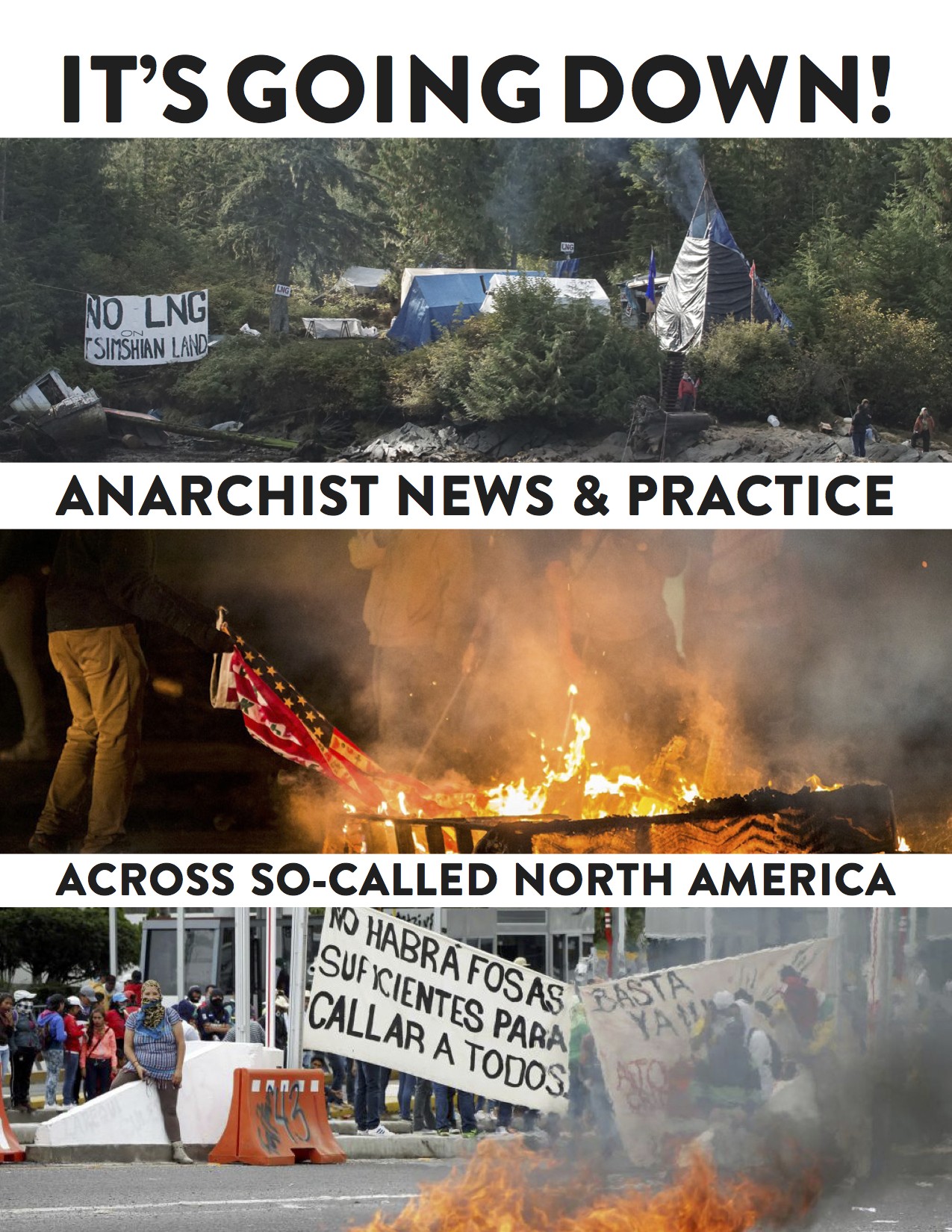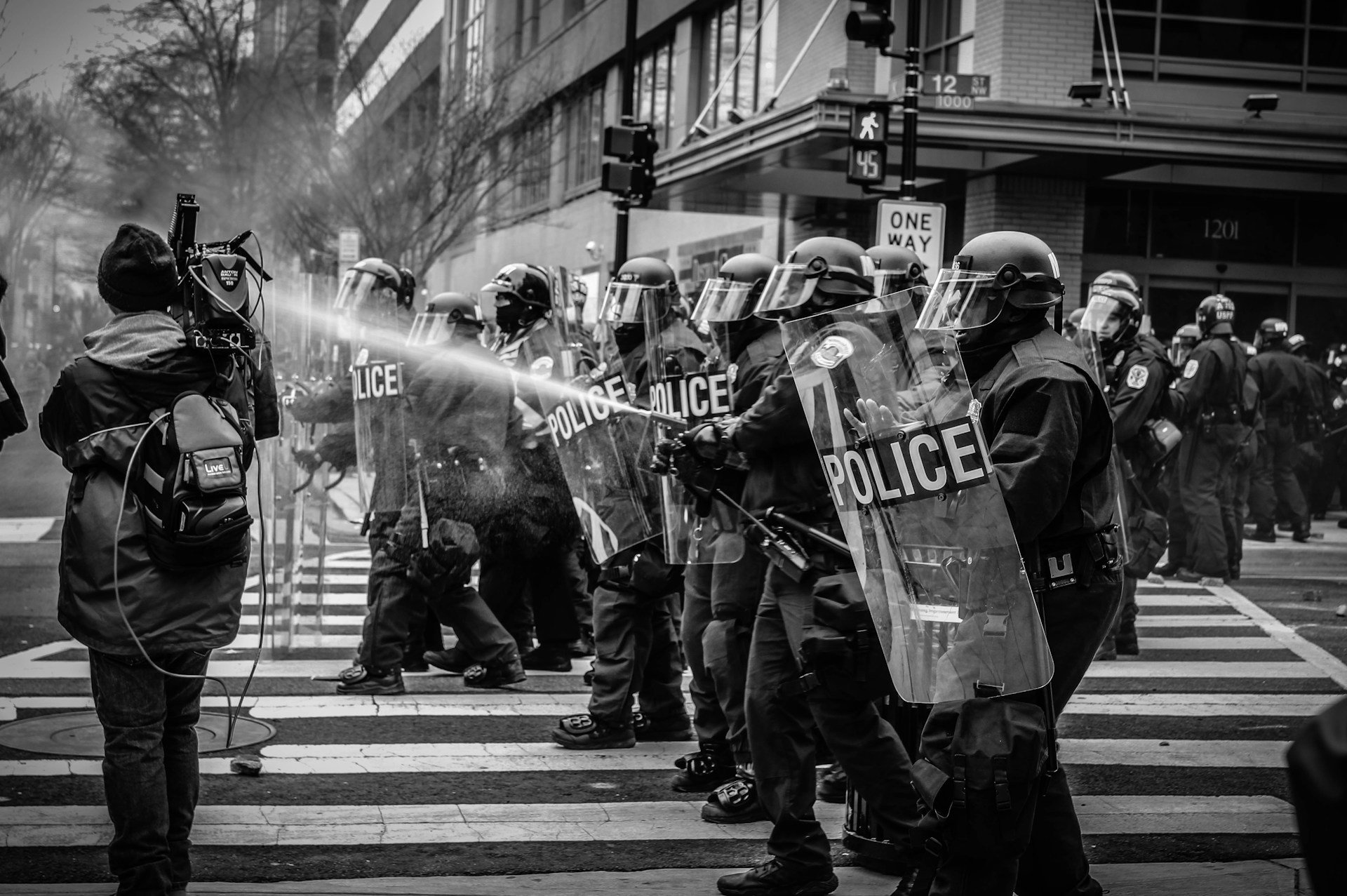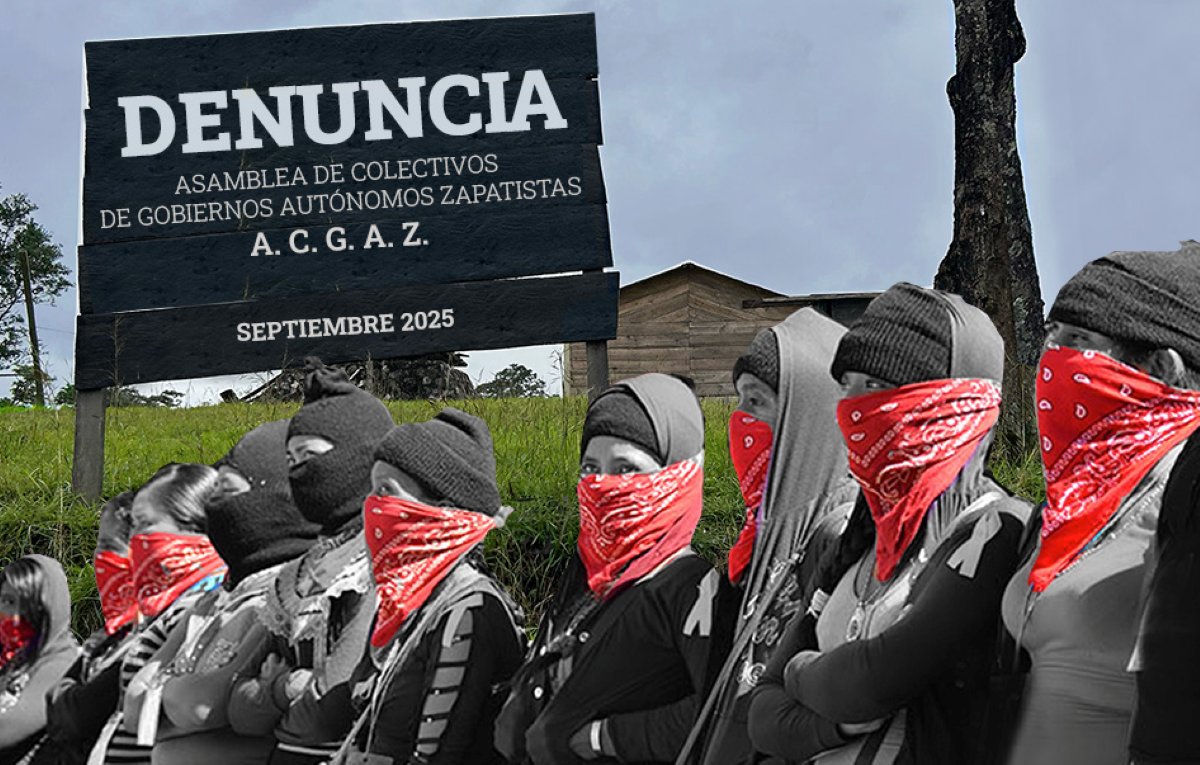Filed under: Canada, Editorials, Mexico, Roundup, US
Originally posted to It’s Going Down
The idea for It’s Going Down started over a year ago and developed out of conversations about the need for a high quality news site that was accessible to the public and was also a tool and resource for those already involved in revolutionary social struggles. Launched in the summer of 2015, we’re happy to note that IGD has grown, slowly but surely.
We’re excited about the future of the site, both in terms of the potential cohesion that it can bring to a wide variety of situations and actions, but also in holding ourselves to a higher standard of thinking about our activity, the strategies we employ, how to address repression from the State, the recuperation and containment of the Left, and also understanding the surrounding terrain of North America in a period of increasing militarization, rising reaction, and burgeoning crisis.
Our Holiday Gift To You
For several weeks we’ve been stating that we were going to announce something big on the website and here at the end of the year, we are going to deliver.

We’ve made a magazine. It has a full color cover, front and back, and is 52 pages long. The magazine is made up of what we feel were some of the most important stories that ran on the website since its launch. These include original essays written and submitted to It’s Going Down, and pieces we republished from other websites. The magazine opens with an introduction written by the IGD editing team and ends with a round up of actions that have taken place in “North America” starting this past summer.
We hope that the magazine provides a much needed tool of reflection and documentation of resistance and the role of autonomous revolutionaries within it across North America. Whether discussing the fight against pipelines, the nature of white supremacy and the rejection of “allies,” the growth of fascism, or the unfolding anti-state struggles in Mexico, we have selected these texts because we feel that they aid in a trajectory of critical strategy and analysis. We couldn’t fit everything we wanted to, but we hope that this is a start.
But we need your help to make this project happen. That is why next week we will announce a crowd-funding campaign to cover our costs. We hope that readers can donate, throw benefits to help us, and share the campaign with friends and comrades.
Looking Back at 2015
2015 was a year marked by showdowns between people and power, both large and small, as well as looming crisis. In the United States, there continued to exist a burgeoning threat of potential rebellion and insurgency against the police and white supremacy, as the spirit of the Ferguson rebellion continued onto Oakland and then to Baltimore. Cities such as Denver, Minneapolis, Olympia, and elsewhere, saw protests, riots, blockades, and more.
According to the website, killedbypolice.net, more people were killed by law enforcement in 2015 than in 2014. Meanwhile, police associations and politicians placed blame on the Black Lives Matter movement for brewing hatred and violence against the police. These attacks were meant to breed justification for mass killing and incarceration, as the police continue to come down even harder in neighborhoods of color in particular, and working class & poor communities more broadly, as they continue to fear widespread rebellion. This clampdown, as we have seen from the choking death of Eric Garner for selling loose cigarettes to ‘routine traffic stops,’ has turned mundane interactions with police into grizzly deaths.
As revolutionaries, it’s important for us to keep in mind that in North America, the police grow out of a colonial and white supremacist framework, that seeks to contain wholesale the population to ensure social peace. For us, we put this contextualization into one of civil war; the increasing violence of the police is part of a campaign of counter-insurgency against sections of the population, and the resistance, fights against it. Within this context, we stress the importance of choosing sides within this war, and deepening, both through action and thought, why we must do so.
Furthermore, we see that the attempts to push for reforms has been largely a total failure, even if it has in the process employed very radical means. One of our tasks is to experiment with and discover tactics which continue to push the envelope of anti-police activity; beyond just protest or the registration of dissent, but into one of the creation of new worlds and expanded conflict with the State.
As autonomous rebels, we also come up against the very real power of the Left and the official organizations which seek to manage and contain outbreaks of social unrest. As the recent protests in Minneapolis showed, the ability of groups that assume a leadership over revolt to pacify people from not only taking action, but also thinking about and getting organized to carry out action, is extremely problematic. Unfortunately, most of the time there seems to be very little criticism even when this happens right in front of our eyes.
Building real relationships with people not only in struggle but also in communities that have the potential to, is a task that we will return to again and again. Towards this end we need ideas, we need action, and we need reflection on past experiments. As we have stated before, the work ahead isn’t often sexy and it isn’t easy. It takes time, commitment, and patience.
As we enter into 2016, the brutality of the police and their continued murder spree shows no signs of letting up. Some police associations have thrown their support behind Trump in an apparent bid for protection from the State against potential reforms. The continued baseline of policing seems to be extreme force without fear of reprisal. Navigating and acting within this terrain is pivotal, both in terms of engagement within revolt when it breaks out and also in building capacity within our neighborhoods and cities against the police.
There has been much written and done in regards to police terror, but often we are too removed or silent when it comes to organizing and action happening behind prison walls. This is why this year, as Black December was called, it has been exciting to see the growth of anti-prison projects which involve prisoners at the forefront. Such projects include the Missouri Prison Newsletter, the Incarcerated Worker, Wildfire, and in the ongoing activity of social struggles such as the fight to abolish solitary confinement. With hunger strikes, riots, and work stoppages taking place throughout North America, we are excited about the possibilities of continued connections and relationships formed.
But while we see possibility in struggles against white supremacy both on the streets and behind the bars, we also are seeing an increase of both the autonomous far-right (from militia groups like the Oathkeepers to white nationalists such as the Traditionalist Youth Network) along side the expanding fascist creep in the mainstream, as evidenced by Trump’s campaign. While discussion of widening fascist activity is something we have talked about much in the past here, it’s worth restating that not since the 1990s has the racist far-Right felt so comfortable in the streets. From neo-Nazis protesting in support of the cops in Olympia, KKK and NSM members rallying in South Carolina, to racist Patriot movement supporters shooting at Black Lives Matter demonstrators in Minneapolis, the Right has been emboldened like never before in recent history.
But we have to remember that outside of demonstrations in the big cities, we have a lot of work to do. White nationalist groups try to make themselves appear to be the saviors (move over Leninists!) of the white poor and working-middle classes in the US. While reading the history of fascism will show that it is an anti-working-class movement that aspires to build ‘cross-class solidarity‘ in order to take the reigns of production away from the ‘capitalists’ and the State from the ‘Marxists,’ this is still a story that has the potential to gain adherents within the wider population.
This is why Trump’s campaign has been successful, because it has coupled anger over jobs (directed at immigrants) and fears of terrorism (pointed at Muslims). At the same time, Trump, a billionaire who has attacked workers of every color left and right, will continue the same economic policies which have lead to a rampaging class war in the US that has increased the wealth gap between rich and poor while production and profits for the wealthy elite (like Trump) have skyrocketed and wages have stagnated and poverty has increased.
But within these statistics are real flesh and blood people, including many whites. By and large unseen or unmentioned in the mainstream media and culture, poor and working-class whites are often made to feel left behind; with only their racial caste position to feel any sense of purpose or position in the world. Ideologies like white nationalism are attempting to speak to and organize within this reality; and they have centuries of racism, patriarchy, homophobia, and colonialism on their side.
But we also have tools on our disposal as well. We have a long history of working-class insurrectionary activity which has attacked the State, capital, and white supremacy. We also can look to various anarchist groups which have organized within poor and working-class white (among others) communities and learn from their previous activity, as well as large scale campaigns in places like Appalachia against Mountain Top Removal. In short, on the anti-fascist front, we face two battles. Both physically against the far-right, but also in the communities they seek to connect to. Any serious struggle must take both facets on with full force.
In the back drop to this all is both the looming ecological crisis as well as the inspiring resistance to pipelines in Canada and across the world. But as discussion and acknowledgement of climate change and the dangers that it brings enters more into the mainstream, it appears that the corporate environmental movement is tightening its grip even more. This month, it was revealed that in Canada large environmental NGOs met in talks with industry heads in order to stop any potential resistance to pipelines in exchange for small reforms. Likewise, 350.org, one of the ‘leaders’ of the mainstream environmental movement, continued its sorry spectacle of “protest” outside of the annual COP gathering. This inability of the major environmental players to summon up any meaningful resistance to industrial civilization is telling: the Left is unable to fight in any meaningful way.
But just as we have our work cut out for ourselves from the need to establish connections and relationships, we also have to think long and hard about what a revolutionary and anti-industrial climate movement would look like. Especially, one out of the hands of NGOs and non-profits. As many have pointed out, the most inspiring resistance to LNG, fracking, and oil pipelines has come from indigenous people in so-called Canada. Here, and conversation is twofold. How do we build solidarity with people resisting on the ground, but also apply these lessons, tactics, and strategies to our own struggles wherever we are? What would it mean to be involved in a fight that wasn’t centered around mass spectacles aimed at getting politicians and industry to change what gives them wealth and power, but instead, destroyed civilization? A struggle that was rooted in the land itself and communities tied to that land, which sought to remove, destroy, and blockade the flows of capital and energy which are destroying life on this planet isn’t going to fall out of the sky; it’ll have to be built.
Grabbing few headlines however, is the ongoing fight for autonomy, land, and freedom in Mexico against the narco-state and police repression. While information about Rojava has increasingly come into North America with exciting tales of the Kurdish fight against ISIS and for a horizontally organized society, in many ways, indigenous and rebel communities have been waging similar, and often no less violent struggles, for decades. This January marks the 22nd anniversary of the Zapatiata uprising, and just in the last year we’ve seen bloody battles by native people’s to kick out the government from their villages, militant struggles waged by Normalista students, and also an extremely intense rejection of the Mexican election. In the coming year, we want to push for deeper connections between rebels in Mexico fighting for land and autonomy with others in North America. If you have connections, ability to translate, or want to help – get at us!
Looking Ahead
2016 we hope will be a year of asking hard questions: where are we weak and why?
We are also excited to see people starting to analyze their local terrain in order to better attack within it. To experiment, to try new forms and projects, expand their spaces, publications, crews and reach out to other communities. We are excited that people are discussing the effects of previous waves of repression and yet continue to move forward, approaching action as a means to create capacity and as a vehicle to get organized around. Hopefully people will use the new year to take stock of their activities, think critically about their activity, and continue to push forward, making new bonds, offering new models, and building our capacity.
On a personal tip: if you want to get involved in this project, hit us up! Let us know how we can improve, what you want to see on the site, what areas and things we aren’t talking about, and if you are interested in putting together and interview, an article, video, or column. Writing can be difficult, stressful, and time consuming, but we want to be a resource for people that are looking to connect and work with us. Let us know how we can work together.





